The Top 5 Most Expensive HVAC & Plumbing Repairs
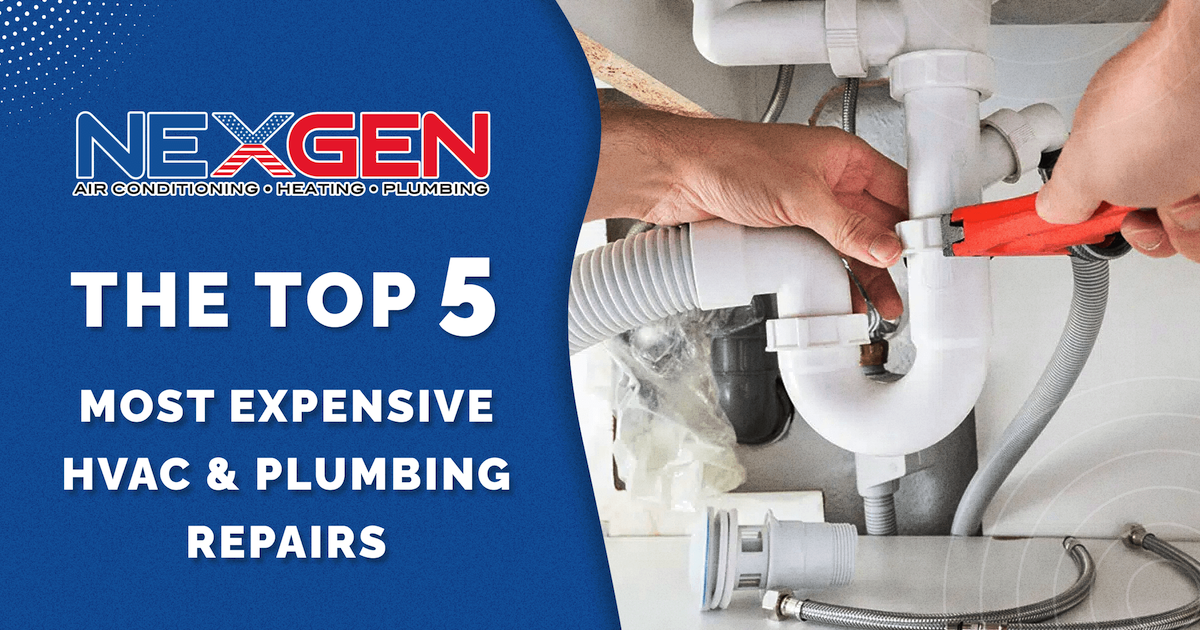
When you add up the expenses of major home repairs, you can understand why proper care and maintenance are so important. Major components and the labor needed to replace them can cost hundreds to thousands of dollars. Here, we’ll look at some of the most expensive HVAC and plumbing repair jobs you might encounter:
-
1. Bathroom Water Damage
Leaking, standing, or running water will damage your home more quickly than you might think. It can soak through flooring materials, walls, and framing. Leaking pipes and fixtures are a common culprit. But a lack of caulking is a serious problem. Periodically check/replace the caulking or grout between tiles or water can easily percolate through and cause the underlying wood to rot. Mold and mildew may be growing below the surface before you know the extent of the damage.
If just everything around your shower space is severely damaged, replacing it all can cost $10,000 to $15,000.1
-
2. Slab Leak Repair
Detecting a slab foundation leak alone can cost several hundred dollars. Thicker slabs may require more time not just to find a leak, but to fix it, especially the deeper the affected pipe is. Repair usually involves removing the overlying flooring, so the type of flooring material to take out and replace is a cost factor. Vapor barriers, rebar, and other materials as well as portions of the foundation may also need to be removed.
Expect to spend up to $4,000, but many variables can jack up the price, including the amount of digging and how much pipe work is needed.2
-
3. AC Compressor Failure
Of all HVAC repairs, compressor failure is the one homeowners dread the most. Fortunately, compressors are very durable and reliable. But dirty coils, low refrigerant, overheating, and electrical problems can strain the compressor and cause it to fail. Replacing it is time-consuming and requires a great deal of expertise.
The average cost to replace an AC compressor is $1,800, but parts and labor costs can be as high as $2,380.3
-
4. HVAC Condenser Damage
The condenser, or outdoor unit, is designed to release heat. Unless it is protected, an exposed condenser unit can be damaged by debris. Electrical problems, refrigerant leaks, and various other problems can occur as well. There are many parts inside the condenser so diagnosing an issue can take some time. Fixing the unit can also take time depending on the location and scope of the problem.
Replacing the condenser coil can cost up to $2,800, depending on the size of the unit. Line and radiator blockages can be just as expensive to fix. Smaller repairs are generally in the hundreds of dollars. These are all far less than replacing the condenser, which can be about $4,000.4
-
5. Refrigerant Leak
Refrigerant lines run throughout your HVAC system. If you notice signs of a leak, a technician must take time to find where it is. Leaks can be detected electronically, via dye, using nitrogen, by looking for air bubbles, or employing ultrasonic equipment. The cost of fixing the leak depends on accessibility, how much damage there is, and the age of the system.
On average, you may spend up to $1,500 on this repair, but fixing a refrigerant line can cost as much as $2,000.5 If the evaporator coil, condenser coil, or compressor need replacement, it will increase the cost significantly.
Schedule HVAC or Plumbing Repair with NexGen
NexGen provides high-quality HVAC and plumbing repair throughout Southern California by licensed professionals. We know such repairs come with unexpected high costs. Therefore, we aim to make service as affordable as possible; members of our X Protection Plan receive a discount on repairs and benefits such as annual tune-ups, a guaranteed service window, and an extended parts and labor warranty. To learn more or request service 24/7, call 833-729-9735.
Source:
- 1. https://www.bobvila.com/articles/5-home-repairs-that-can-break-the-bank-and-how-to-avoid-them/
- 2. https://www.homeadvisor.com/cost/plumbing/
- 3. https://www.homeadvisor.com/cost/heating-and-cooling/home-ac-compressor-replacement-repair/
- 4. https://www.homeadvisor.com/cost/heating-and-cooling/repair-replace-ac-condenser/
- 5. https://homeguide.com/costs/ac-leak-repair-cost
Air Conditioning Installation: A Step-by-Step Process
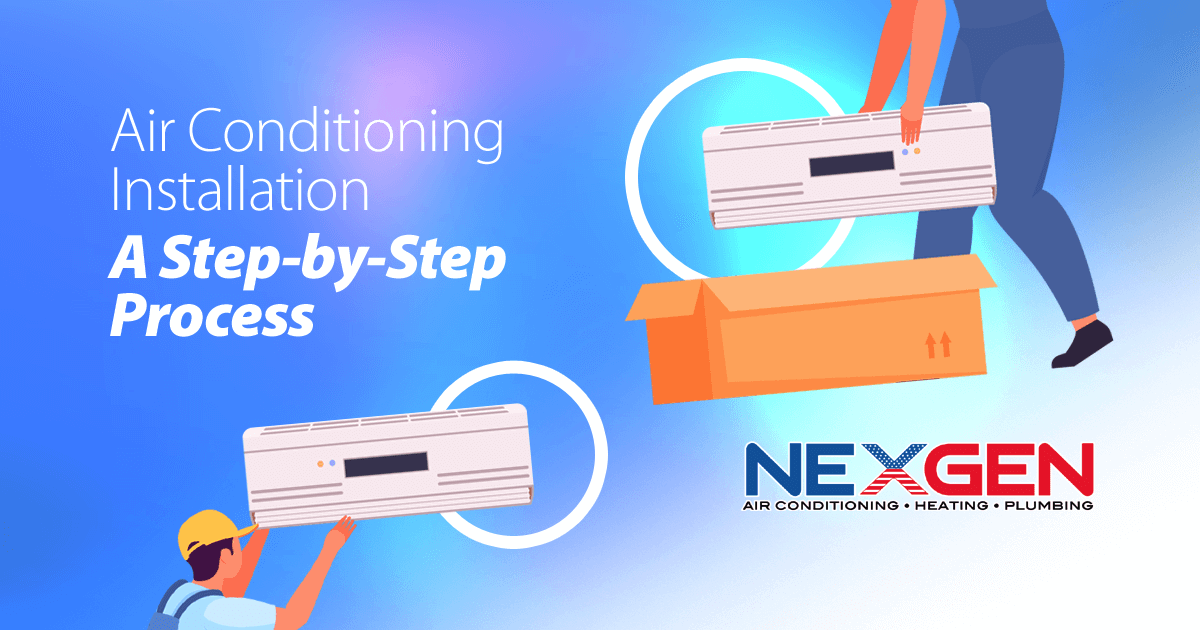
Whether it’s been 15 or 20 years since installing your air conditioner, the time may have come to replace it. That’s a pretty good length of time. Even well-maintained AC’s eventually reach the end of their life. At NexGen, we’ve provided air conditioning installation in countless homes and businesses. In this step-by-step guide, we’ll provide a look into our process that ensures your investment pays off.
Step 1: In-Home Consultation
Assuming your current AC isn’t fixable, we’ll send a licensed contractor to evaluate what you have and what type of air conditioner is best for your home. Newer air conditioners tend to be larger to accommodate larger, more efficient coils. Therefore, the location of your existing AC may not be sufficient. A different area may need to be considered.
Another factor is the unit’s cooling capacity. You don’t want an AC that’s too small or too big or it won’t run efficiently. This can reduce comfort and strain the system so it costs more to run and repair more frequently.
Step 2: Removing the Old System
To remove an old AC system, several complex tasks are required. First, the refrigerant must be removed; this involves specialized equipment and a trained technician. By law, only EPA-certified personnel can remove, handle, and dispose of refrigerant, which can be toxic. Coolant cannot be vented into open air; a sophisticated machine pumps it into a recovery tank.
It's also necessary to protect areas of your home. Air conditioning equipment is heavy and there may be debris to clean up. During this process, installers will cover floors and furniture for protection and also inspect for sealing issues in your home and air duct leaks. These can impact the performance of a new system so must be fixed before installation begins.
Step 3: Preparation
The pad for the old outdoor unit must be replaced to accommodate the new air conditioner. Newer units are larger and wider. The ground may also need to be leveled before the technician can set the new pad. A gravel base should be used to level the area or build it up, while a vibration-absorbing composite pad is preferred over poured concrete that can crack and shift.
The area must be stable, as moving or lifting the air conditioner can cause severe damage. Rigid internal components cannot withstand much motion, while some are pressurized as well. Once the system is connected, it must remain in place, so the pad won’t need repair during the unit’s lifetime.
Before the indoor evaporator coil is replaced, the metal plenum is disconnected. Refrigerant lines, which consist of two copper pipes, may be reused (and first flushed, cleaned, and pressure-tested). However, a technician will likely recommend installing a new line.
Refrigerant lines are often strapped to the bottom of floor joists. Straps must be removed before taking out the line set. Line sets may also be located within ceilings or walls or buried underground. To make things easier, a new line set may be run while the old one remains.
Step 4: Outdoor Unit Installation
The AC condenser is placed on the composite pad and inspected for potential damage. Next, the line set is fitted to the new unit’s service valve, which isolates the refrigerant and the outdoor condenser from the indoor coil. This avoids having to replace refrigerant if a repair is needed. The copper line set and valves are brazed, or welded, together to ensure a leak-proof connection. Then the filter dryer is installed in the condenser, preferably next to the expansion valve, to absorb moisture and provide filtration.
Step 5: Wiring Installation
The new service disconnect box is mounted to the side of your house and wired to the electric panel. An installer may provide a fused box that supports overcurrent protection, or a non-fused box if the existing breaker matches the AC manufacturer’s listed maximum overcurrent protection. High- and low-voltage wiring will then be reconnected; line, or wiring from the panel, and load, a power conduit to the AC, is connected. All electrical installations are installed in accordance with the National Electrical Code (NEC).
Step 6: Indoor Evaporator Coil Installation
A cased evaporator coil is preferably installed. It has an insulated cabinet with panels that allow access to the coil and sits on top of the furnace. The coil is then connected and sealed to the existing sheet metal plenum. Uncased coils require additional preparation and installation work before connecting them. Rails must be installed to ensure the coil sits above the furnace heat exchanger at the proper distance, or else the drain pan can melt. But if the opening isn’t big enough or too much air can flow through, the coil will freeze.
Step7: Refrigerant Line Installation
Refrigerant line sets include two copper lines; the suction line is larger and insulated, while the liquid line is smaller. Rolled into a coil, these are available in lengths of 15 to 50 feet. Lines are set near beams and ductwork, if possible, and secured every 4 to 6 feet with plastic or copper strapping. Once hangers are installed to secure the lines, the suction line is usually installed first and connected to the AC, and run to the indoor evaporator coil. The liquid line is then run along the same path and secured.
Installers will take care not to bend, kink, or otherwise damage the lines. During the process, the installer will push unrolled sections of tubing through a 2” to 2.5” hole in the outside wall near the AC. Just enough line is then pushed out to reach the service valve. When refrigerant is added, special care is taken not to expose it to the air and contaminate it.
Heat protection is then applied and dry nitrogen is used to protect the interior of copper tubing from oxidation during welding. Dry nitrogen also allows the installer to perform a preliminary leak test, collect moisture, and purge some contaminants. A vacuum process is then used to remove oxygen, nitrogen, and moisture that can affect the operation and damage the system.
Step 8: Condensate Drain Line Installation
The primary condensate line runs from the evaporator coil to a floor drain or condensate pump. A PVC pipe allows moisture to flow from your home when the AC is running. Condensate tubing or piping is secured and glued when installed to protect against flooding, and a safety overflow switch is connected to the evaporator coil’s secondary port. It’s also wired to the furnace control, so the system shuts off when tripped.
Step 9: Thermostat Installation
During air conditioner installation, a new thermostat is usually provided. If you keep your existing thermostat, the installer will check the connection between it and the new system. They can also install a separate thermostat if you want a smart system, for example. Your AC installer should also demonstrate how to use your new thermostat.
Step 10: System Testing
The technician will run the air conditioner for up to 20 minutes. During initial startup, refrigerant will start flowing and the system will start to condition the air. It will feel warm at first. But you’ll soon start to feel the difference. All the while, the unit’s sequence of operation, thermostat function, and a range of parameters will be tested.
Schedule AC Installation with NexGen
Our experienced technicians can inform you about different types of air conditioners and what may be best suited for your home. They are trained to install any type of AC unit or brand as well as all necessary components. Comprehensive maintenance plans and warranties are also available. To learn more or schedule air conditioning installation in Southern California, call 833-729-9735 today!
How Do Air Purifiers Work?
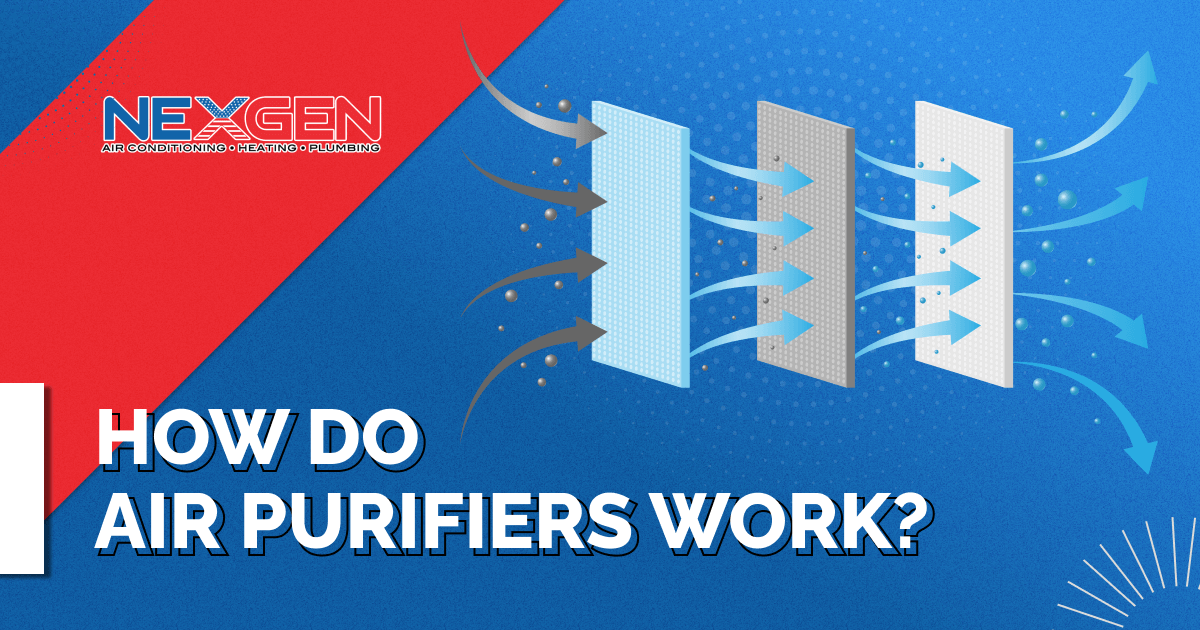
While an HVAC system offers some air filtration, it doesn’t filter out every particle of dust, pollen, or pet dander. Mold spores, smoke, odors, and other pollutants and potential toxins may exist in your indoor air, where they can be many times more concentrated than outdoors. An air purifier can remove these and improve comfort, help alleviate allergies, and reduce the risk of respiratory and other illnesses. In this article, we will answer the question, “How do air purifiers work?” to show you their potential benefits.
Function of an Air Purifier
An air purifier is an appliance that sucks in air via a fan and re-circulates it in a cleaner form. It can have one or multiple filters. These filters can be made of paper, fiberglass, or mesh. Some filters must be replaced as they fill up, while others are reusable and washable (however, they require substantial maintenance, but are effective at removing larger particles).
Filtration is an important aspect of air purifiers, but a purifier is much more than a filter. Some models act as air sanitizers as well. For example, air particles can be neutralized when ultraviolet light (UV) filters are integrated into the unit. UV light can destroy bacteria, mold, and other biological impurities. Without a special filter or sanitizing system, an air purifier will struggle to trap particles much smaller than 5 microns in size (high-efficiency filters can remove particles as small as 2.5 microns).1
*While coronavirus (COVID-19) particles measure about 0.1 microns, they’re usually bound to water droplets, aerosols, and other larger particles, so can be removed by air purifiers.
Air Purifier Limitations
A standard air filter struggles to remove volatile organic compounds (VOCs), radon, and other gases. Off gassing from household cleaning products, paints, and adhesives isn’t captured by most air purifiers either. That’s unless a High Efficiency Particulate Air (HEPA) filter is used. It’s made of fine fiberglass threads and is pleated and sealed in a frame made of plastic or metal.
HEPA filters capture particles of various sizes, including VOCs, ozone, carbon monoxide, nitrogen dioxide, and sulfur dioxide when used in combination with UV light and air scrubbers.
But an air purifier won’t remove or neutralize particles stuck to walls (and other hard surfaces) or sitting on carpeting, furniture, bedding, and other soft surfaces.
When asking, “How do air purifiers work?” and deciding on the best one for your home, it’s also important to consider the following:
- Air Purifier Size: Each model is rated for a specific room size. If you choose a unit for a larger area than you have, it can be run at a lower setting to reduce noise.
- Clean-Air Delivery Rating (CADR): Aim for at least a CADR of 300, but a rating of 350 or higher is very effective at removing smoke, dust, and pollen.
- Association of Home Appliance Manufacturers (AHAM) Verification: The AHAM certifies various types of appliances to ensure their performance, safety, and efficiency.
Types of Air Purifiers Nexgen Offers
Nexgen offers three different types of air purifiers. These include filter-based systems with electrically charged flat filters to capture large particles, extended media filters that remove dust and debris, and ultraviolet filters. In addition, we offer duct-based air purification systems designed to filter impurities from air as it passes through air ducts. Lastly, our stand-alone systems install in a closet or attic and are connected to your HVAC system via air intakes. Our licensed technicians can perform any installation for you, while your budget and air quality needs are addressed as part of our X protects standard.
To learn more or have an X-purification system installed in your home, contact Nexgen HVAC & Plumbing at 833-729-9735 today!
Source:
- https://www.livescience.com/how-do-air-purifiers-work
10 Signs Your Air Conditioner Needs Repair
Knowing when you need AC repair allows you to call a contractor before the damage is more expensive to fix or your system needs to be replaced. You can also avoid a sudden failure on a hot summer day. Nexgen can be reached 24/7 to promptly address any issues you’re having. To help you know when to call for service, here are signs your air conditioner needs repair.
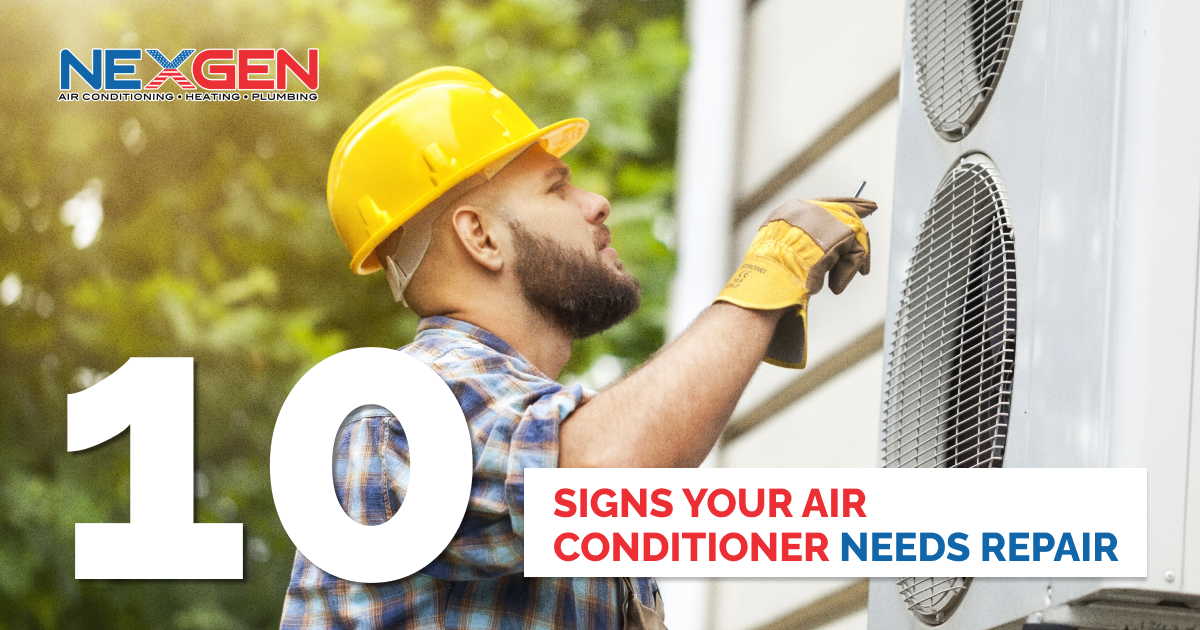
1. Only Warm Air Is Blowing
An air conditioner is designed to provide cool air. When the AC is turned on, there should never be warm air blowing from the vents. If so, check that the thermostat is in cooling mode. Otherwise, warm air blowing can mean something is blocking airflow or there’s damage to the compressor.
2. The AC Is Making Odd Noises
If the unit is making sounds you’ve never heard, it’s time to call for repairs. There may be a blockage or a mechanical problem. Worrisome sounds include grinding, scraping, squealing, or gurgling. Ignoring the noise can lead to more serious and expensive damage.
3. It’s Turning On and Off Too Fast
Air conditioners typically run in cycles. They stay on until the set temperature is reached, and turn off until the temperature needs to be readjusted. Your AC will run more frequently on hot days. If it’s constantly turning on and off, the system may need to be repaired or replaced.
4. Vents Are Blowing Little or No Air
Even if you’re getting cold air, weak air flow is a sign of a duct clog or leak. It can also mean the compressor is failing. If there’s a ductwork issue or a motor is breaking down, the problem can be fixed. In some cases, the issue is so serious replacing the unit is the only solution.
5. You Can’t Get the Thermostat to Work
The thermostat is what controls your air conditioner. It measures temperature continuously to signal the AC to generate the right amount of cold air. Signs of a thermostat problem include the system not turning on at all, running for short amounts of time, or not providing the right temperature.
6. The AC Gives Off Bad Odors
There are also smelly signs your air conditioner needs repair. If there’s a musty odor, mold may be growing inside the AC unit or your ductwork. A burning odor can mean a wire or electrical component has burnt out. Ductwork cleaning, a tune-up, or installation of UV lamps in the system can eliminate AC odors.
7. Your Electric Bill Is Going Up
Your utility bill should remain fairly consistent. If you’re not using your AC more, but are spending more on electricity, there may be a repair issue such as a duct leak, faulty thermostat switch, clog, or other mechanical problem causing it to work harder.
8. The Unit Is Leaking
Refrigerant is constantly circulating throughout the system. Central air conditioners are also designed to drain condensate. If you see coolant pooling up, this can be a dangerous situation, while leaking water can cause serious property and structural damage.
9. Your Home Is More Humid
Even on humid summer days, your AC should keep indoor humidity levels in check. Schedule service if your home starts to feel stickier. If the humidity is above 50%, your home can become quite stuffy while mold can grow more easily. Watch for low-humidity and dryness as well.
10. Circuit Breakers Keep Tripping
If the breaker for your AC keeps tripping, there might be a serious electrical issue. An undiagnosed electrical problem can lead to equipment overheating or wires sparking. A home fire can result if the problem isn’t diagnosed and fixed.
Contact Nexgen for AC Repair
Are there signs your air conditioner needs repair? If so, Nexgen is ready to assist and can provide any repair necessary, starting with a free estimate. Maintenance and tune-up specials are available as well. Call 833-729-9735 to request a visit.
NexGen is a trusted name in plumbing, air quality, and HVAC in Palm Desert, Anaheim, Riverside, Los Angeles, and other parts of the area. We’re also committed to giving back to the community through our Project X program and Military Appreciation Program (MAP). As part of MAP, we donate four systems a year to veterans to show our appreciation for their service. In this article we will discuss our recent AC donation to veteran John Engles.
About John and Robin
John Ingles is an 86-year-old veteran of the Korean War, he was drafted to in 1953. He later served as a paratrooper after extensive training. Engles is described by his neighbor as kind, loving, and giving with a lot of integrity and honor.
Robin, John’s neighbor, has lived in Desert Hot Springs for 22 years and has known John for nine years. She’s been a caretaker for her disabled sister for three years. One day, she realized how hot it was in John’s house, where it could be over 100°, and began the search for an air conditioner repair company. In the area, daytime summer temperatures can exceed 125°.
John’s AC Troubles
The heat in John’s home was so bad that Robin was prepared to call 911 or take him to the hospital. After waiting two weeks for a repair company to visit, and trouble getting financing, John felt like there was nowhere to turn. That is until Robin noticed the NexGen signs on the freeway.
After contacting NexGen, Ruben, the service manager in Palm Desert, sent a crew out for a diagnostic. They determined that the HVAC system in John’s home needed to be replaced. Ruben mentioned the Project X program after learning John Engles was a veteran. He then sent through the paperwork and John was approved.
Install manager Ernie Perez led NexGen’s installation of a furnace, coil, condenser, and other equipment for use during any season. A complete system was installed in one day. In a video, he also explained how devoted he and NexGen are to helping out the community to ensure people are cared for.
John Engles too expressed his gratitude, saying, “I would like to thank NexGen and ProjectX for my new system. I owe my life to them and thank you immensely.”
About Project X
Project X is a program in which someone can be nominated to be a recipient of NexGen’s services. It helps support local and larger projects that protect/honor the community and people in it, and that contribute to improvement. The company already tries to make HVAC service more affordable with flexible financing. Project X adds a new dimension by helping serve those most in need. To nominate a recipient, NexGen provides a form online in which their name, contact information, military branch and ID, and background story can be submitted.
Contact NexGen Today
NexGen is an industry leader in heating and cooling system installation and repair in Southern California. Also trusted for plumbing, drain cleaning, and air purification solutions, we are devoted to serving the community through the Project X program and making sure all customers get the best care through our X Protects services. We’re also known for competitive pricing, professional installation, and free, friendly estimates. A lifetime warranty is provided with our brand as well. For more information about our company and services, call 888-966-9045, or feel free to book your appointment now online.
Which type of HVAC unit is right for my home in Orange County?
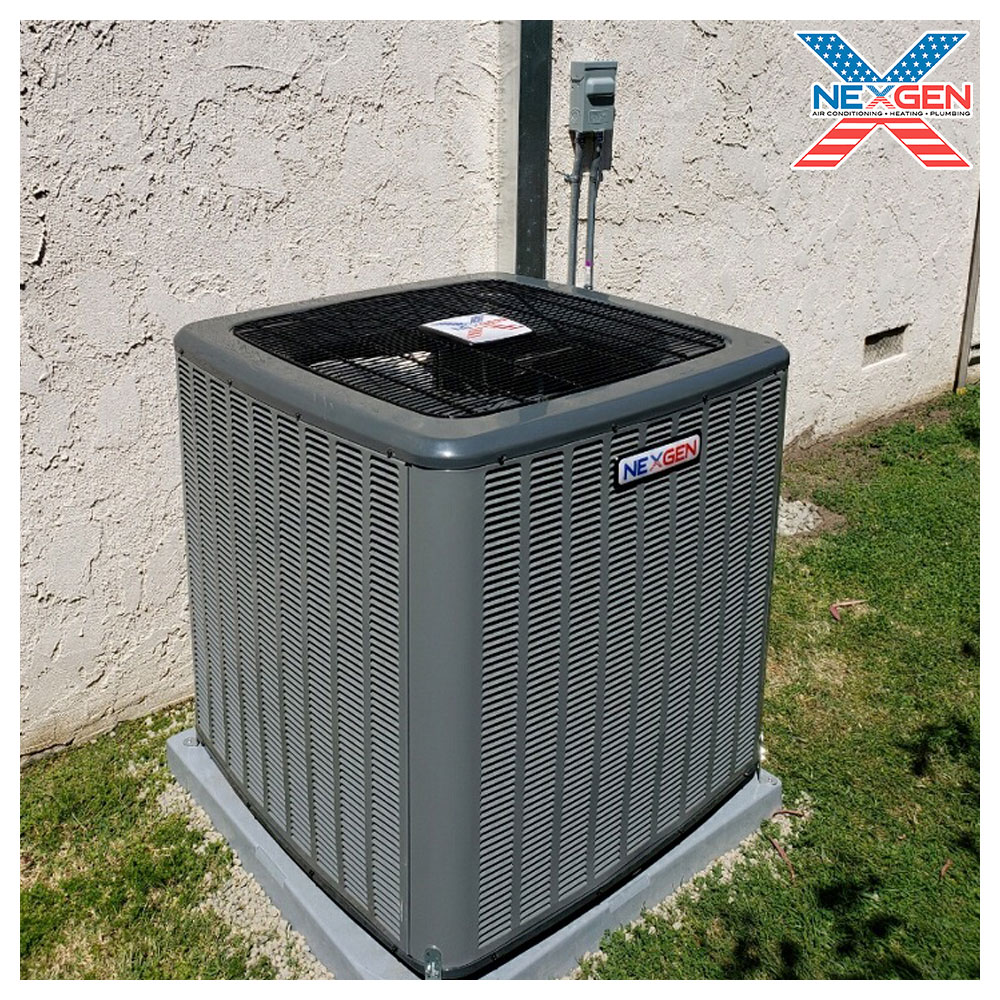
Are you tired of the high energy bills every month? If yes, it is important to ensure the optimal performance of your air conditioning unit.
Although Orange County does not have high temperatures, it is still essential for residents to have the perfect HVAC unit for their homes.
Types of Air Conditioning Units
It is important to learn about the various types of air conditioning units available to make the right choice. Currently, they are four different types available. All come in different sizes and specifications to suit various home and business designs.
They include:
Heating and air conditioning split system
– having an outdoor unit having the compressor and condenser, and an indoor unit containing the blower and evaporator coil.
Hybrid heat pump system
– uses a heat pump together with a furnace to burn natural gas, fuel oil or propane to cool or heat your home.
Ductless mini-split system
– it gives solutions to spaces where the other types are not compatible.
Packaged air conditioning and heating system
– containing the condenser, compressor, and evaporator all in a single unit.
Air conditioning repair in Orange County
Most homeowners in Orange County face difficulty when deciding whether to repair or replace their AC unit. The last thing anybody wants is to make a wrong decision on this type of investment – several options need to be weighed before making this decision.
One of the most important is the lifespan of the conditioning unit. According to a US Environmental Protection Agency, an AC unit should last for an average of 15-20 years, a heat pump for 16 years, and a furnace for 18 years.
How to Choose
Use these guidelines to make your decision:
1. Safety concerns
The most important thing to consider is safety. If the heating system presents a kind of hazard, then it should be replaced, especially if the repair is going to be temporary and very expensive.
If your furnace has a cracked heat exchanger, for example, it could result in carbon monoxide leaking into your home, and could potentially be fatal. Don’t take this risk. But things like faulty wiring and stuck valves may just require a simple repair.
2. Its lifespan
The next thing to consider is the age of your cooling unit. In some cases, a licensed and trained technician will write down the date of installation on the unit. If not, check the chamber door for the identification plate containing the model and serial numbers. Use these numbers to ask the customer service for the manufacture date.
If your unit is older than 20 years, it doesn’t necessarily mean you must replace it. The average life expectancy dates are average, meaning the unit can still work.
3. Cooling and heating effectiveness
If the cooling or heating system is faulty, it will not cool or heat your home effectively. A good sign to know if the system is flawed is when the unit is not cooling or heating the house at the temperatures you set. Older units will have this difficulty, you might notice if some rooms are colder or warmer than others.
4. Repair costs
If you are still unsure and realize your unit is under 15 years old, then it may just need a repair. It is no doubt that AC units will need some repairs once in a while. But if your system regularly requires repairs, it can eventually cost you more than having a new unit installed. Other signs that indicate you need an AC repair in Orange County are:
More dust accumulates in your home
It makes a strange noise
You smell unusual odors
An increase in your electricity bill
Call NexGen Today
Our expertise and commitment to customer satisfaction make us the leading HVAC company in Southern California. To learn more about our equipment, services, and protection plan,
book an appointment online or call
888-277-0415.
Tips for lowering your cooling costs
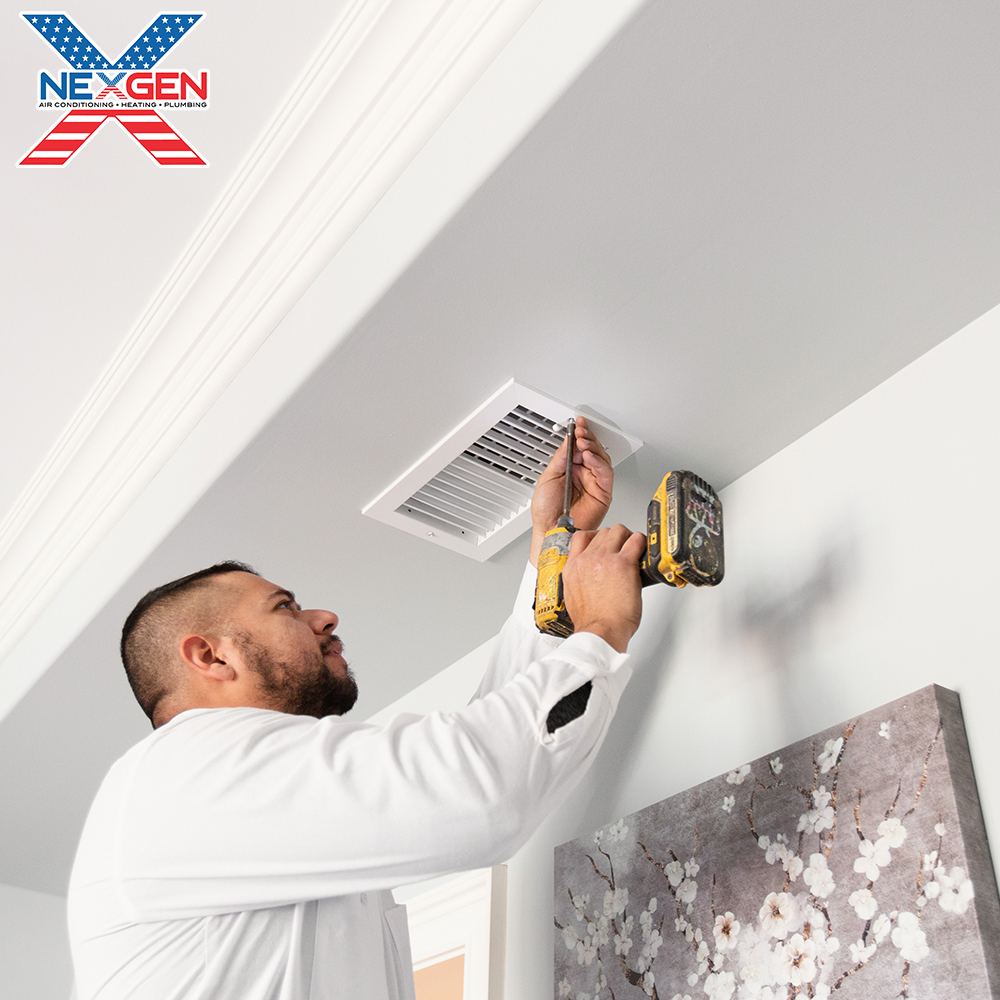
Are you tired of the high energy bills every month? If yes, it is important to ensure the optimal performance of your air conditioning unit.
Ideally, you should immediately get your AC checked if you hear strange noises or observe a stark difference in the airflow. While these issues might seem minor, they can take a bigger shape in the long run.
The result: a waste of money, time, and effort.
The right AC service company will send expert professionals to your homes who will check the AC and conduct the necessary repairs right away. Having serviced multiple homes and businesses, these experts will carry out the right repairs. This will not just save your costs, but also save plenty of effort. In case you’re still hesitant and are wondering how to lower energy costs, here are some things you should know about!
Run Your AC Economically
If you’re looking to cut down on high energy bills, it is essential to run your AC more economically. You can do this by setting it at a temperature according to your liking and use a programmable thermostat to tweak it when you’re out. This can decrease your cooling bills by 10%.
Get Your AC Checked
Getting your AC checked is essential because it plays a significant role in boosting the energy efficiency of your home. Since it also reduces the operational costs of ACs, these services are practically indispensable for your property. The right air conditioning service in Palm Desert will ensure your air conditioner is cleaned of every minor and significant speck of dirt or debris. What’s more, they will also ensure that your system runs at its maximum potential. You can choose annual or quarterly servicing for the best results.
Maintain Your Cooling Unit
If you have a car, you will know that the better you maintain it, the longer will it offer you service. Interestingly, your air conditioning device works in the same fashion. A basic air conditioning unit can run for 15 to 20 years. And when you get regularly assessed by an expert, you will end up getting more miles on it. The right AC repair palm desert will enhance your system’s efficiency so that it lasts you for several years down the line.
Do Not Ignore Minor Issues
Very often, we ensure long-standing issues in our air-conditioning units deeming them as minor or inconsequential. But such is not always the case! Unless you address them at the right time, these issues can take a terrible shape, eventually resulting in expensive repairs. A good air conditioning repair Palm desert company will identify and address the issue at the right time. The result: you’ll be saved of hefty and expensive repairs in the long run.
Are These Professionals Worth Your Time?
Yes, AC repair experts are certainly worth your time. With several years of experience and complete understanding of business, these professionals are fully aware of what’ll work best for your air conditioning system. The carefully assess your systems and offer solutions that keep it up and running for a long time. So, if you are really looking to save costs, time, and efforts, consult these professionals right away! With their right expertise, NexGen will ensure that you do not shell out thousands in energy bills. Our team will make sure that your AC is fully functional and efficient, just like you always wanted.
Call NexGen Today
Our expertise and commitment to customer satisfaction make us the leading HVAC company in Southern California. To learn more about our equipment, services, and protection plan,
book an appointment online or call
888-277-0415.
Why is your HVAC system important when living in Los Angeles?
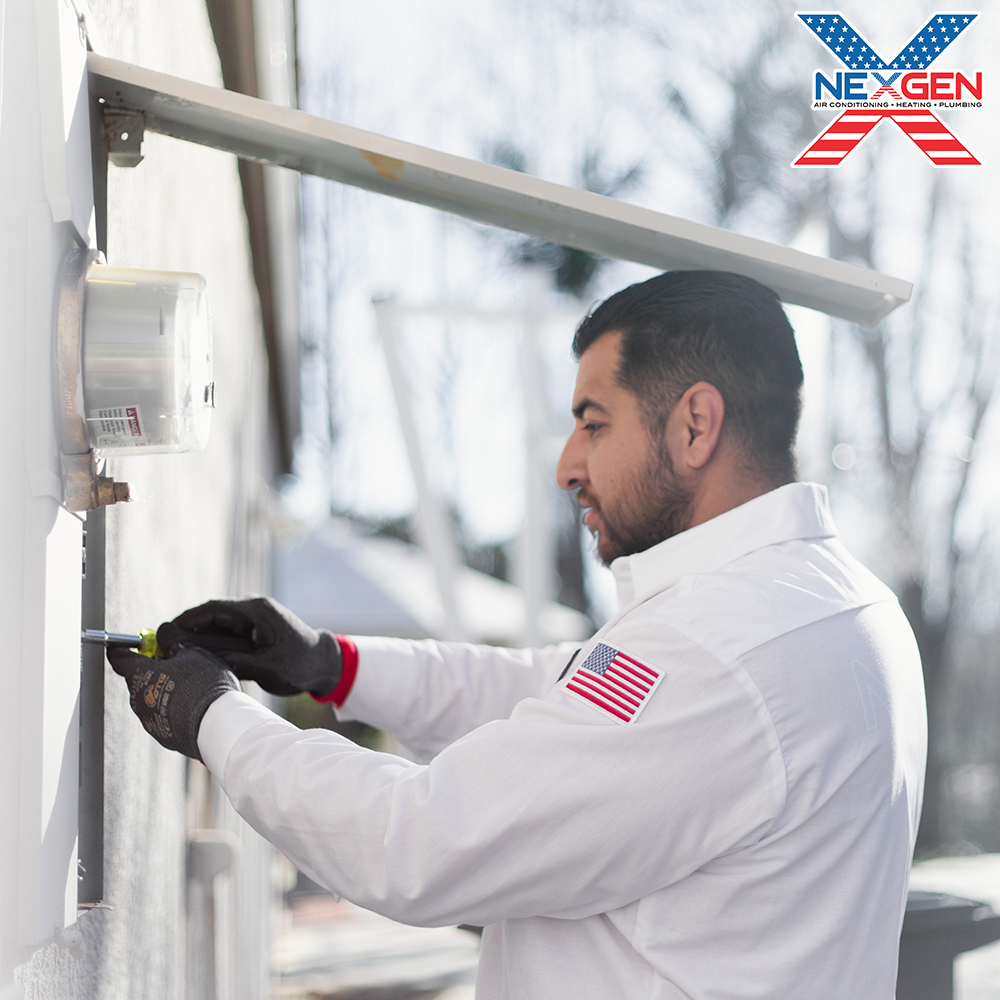
Heating, ventilation, and cooling, abbreviated as HVAC, is a system that cleans the air and offers warm air or cold air depending on the user’s climate requirements. In Los Angeles, HVAC systems are considered a worthy investment because of their incredible energy-saving principles.
If your HVAC system is damaged or is more than 15 years old, you must upgrade to a brand new, high-efficiency HVAC equipment. At NexGen, we offer professional repair and installation solutions on all AC systems in Los Angeles. We can assist you with all the heating and air conditioning systems requirements you need.
Pros of Having an HVAC System in Los Angeles
Because of advancements in technology, present-day HVAC systems can maintain a constant temperature in all the rooms in your home. Quality HVAC equipment has top-notch energy control and offers a consistent level of airflow. Pair this HVAC system with a smart thermostat and a comfort zone control system, and your home becomes an energy-efficient fortress. All of these also ensure you have a more comfortable and updated house to live in.
Lower Electricity Bills
An HVAC system is a piece of energy-efficient equipment that can significantly lower your electric bill to a great extent. Moreover, switching to a more advanced HVAC system reduces your carbon footprint, which is a significant step to preserve our unique planet from pollution.
Cleaner Air
Having a smart HVAC equipment enables you to have a constant flow of clean air. This helps to reduce stuffiness and drafts. Here at NexGen, we will install an HVAC system that ensures stable comfort levels and boosts the quantity of fresh air.
The Best Air Conditioning Service in Los Angeles
If you are hunting for dependable AC repair in Los Angeles to handle all of your heating needs, then NexGen is here to help. Our team can keep your HVAC system maintained and ensure your home is having a constant flow of cold air. We provide full heating and air conditioning services on residential properties within Los Angeles and the neighboring areas.
State-of-the-art Tools and Equipment
At NexGen, we have invested in great repair tools. We use state-of-the-art technology to make sure you get the best HVAC service. Our incredible team of technicians have extensive experience and use their remarkable skills to give you top-of-the-line AC repair solutions.
Exceptional Customer Care
We give our clients the number one priority always, and as our customer, we will handle your HVAC system repair with the professionalism that the project deserves. Our family will treat you like family. Our team commits to going the extra mile.
Request for a Free Estimate
Looking for the best air conditioning repair in Los Angeles? Call us at NexGen today for high-quality AC repair, excellent customer support, and affordable costs. You can contact us for a free consultation and estimate on all the AC services we provide.
Call NexGen Today
Our expertise and commitment to customer satisfaction make us the leading HVAC company in Southern California. To learn more about our equipment, services, and protection plan,
book an appointment online or call
888-277-0415.
Should I replace or repair my HVAC unit?
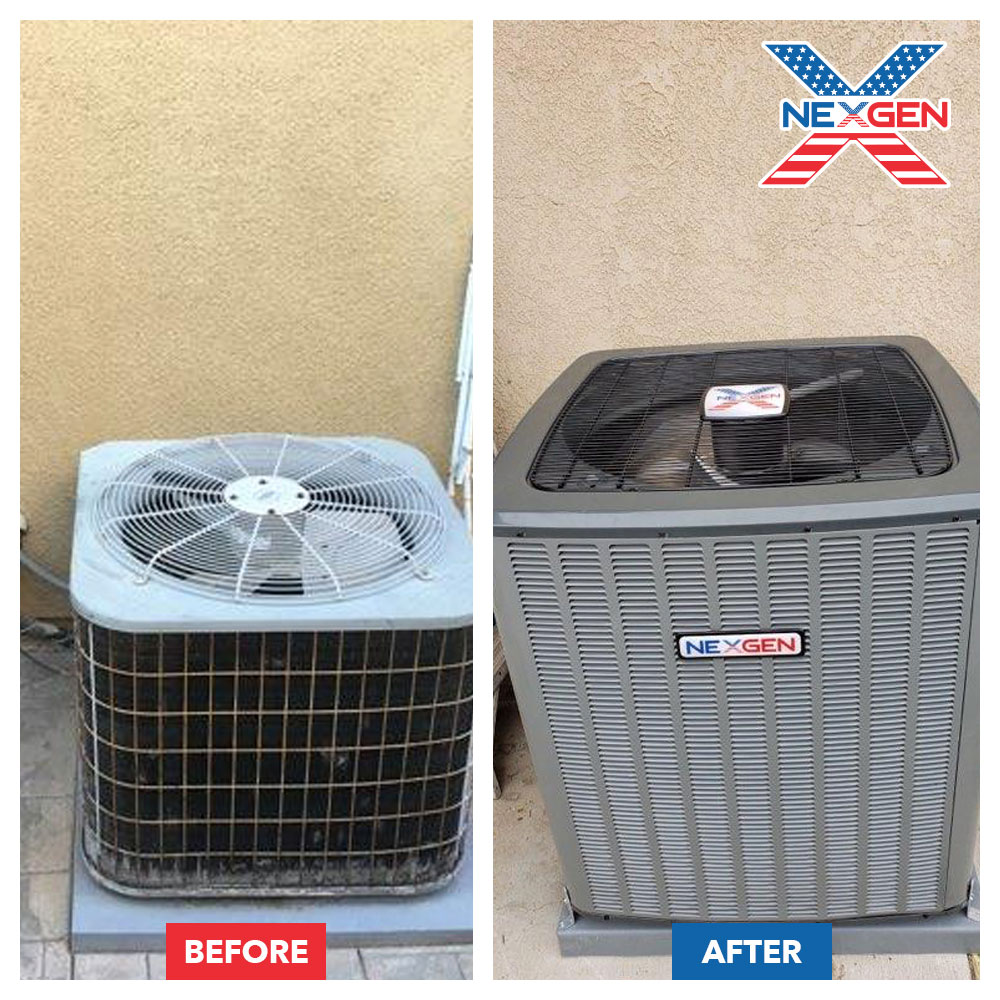
Figuring out whether an AC unit needs a repair or replacement is tough. If your unit is not more than one decade old and performing well, then you can consider repair. However, longevity is not the sole determining factor.
Performance, regular maintenance, and a few other factors can help you to decide either replacement or repair is due. You can call for an AC repair in Inland Empire before considering a costly replacement.
You can also go through these signs to make the right decision.
When to Replace
If your air conditioning unit is more than one decade old and needs frequent repair, then it is better to go with the replacement. When it is more than 10 years, you will have to spend more on repairs or part replacement. Also, energy efficiency will be compromised. In some conditions, it might not offer the required coolness as well.
If there is an unexplained hike in maintenance expenses, then you will have to think of a replacement. Instead of spending more on repair or energy, you can take the call and go for the replacement to get long-term benefits.
Here are some signs that indicate the need for a replacement.
- Leak: You cannot repair seals or tubes if your condenser starts to leak. In that condition, you will be left with only one choice which is a replacement.
- Blockage: Blockage is a sign of a severe problem. When there is a blockage in your system, you can consider replacing the condenser. You might need to replace some other expensive parts like the compressor depending on the damage. Instead of investing in parts, you can think of a replacement, if possible.
When to Repair
In most of conditions, you can go with the repair, especially when your system is new. An air conditioning service in Inland Empire can help you with the right solution. You might not have to spend more on repair if the issue is minor. You can consider repair when it has a good SEER rating. Also, when your system is less than ten years old, you can fix most of the issues.
If your system is offering the required coolness without increasing the monthly energy bill, then you should not go with a replacement. The same is about frequent repairs. If it does not require frequent and costly replacement, then you can save on replacements.
Here are some signs that indicate your AC unit needs repair.
- Run Capacitor: You can easily repair a capacitor. Take the help of technicians to fix it fast.
- Condenser Switch: It is easy to repair a condenser switch. If you find issues with the condenser, check the switch first to know the cause. You can easily repair or even replace it without spending much.
When you notice that your AC system is not performing up to expectation, check it with an air conditioning repair in Inland Empire to find out the cause. Follow the above tips to decide if it is time to repair or replace your system. If you do find yourself in need of a repair or replacement, NexGen is here to help. Our experience and skills make us the perfect choice for your HVAC unit needs in the inland Empire. Call us today and let us help you decide what would be best for your unit.
Call NexGen Today
Our expertise and commitment to customer satisfaction make us the leading HVAC company in Southern California. To learn more about our equipment, services, and protection plan,
book an appointment online or call
888-277-0415.
How to Get the Most Out of Your AC System in Northridge
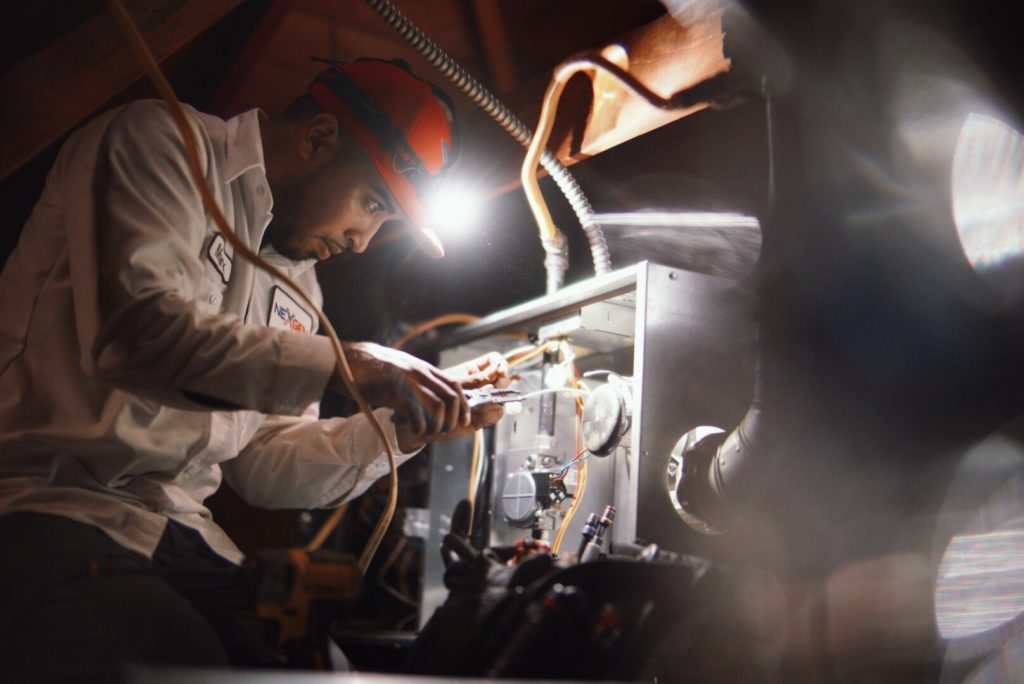
Are you one of the lucky residents that get to call Northridge home? Living in Northridge has so many advantages that the residents get to utilize! The city of Northridge is known for its friendly communities, wonderful parks, and even better schools! The weather in the area is always sunny and comfortable, it’s no wonder so many people choose to live in the area! The city is referred to as the “Jewel of the San Fernando Valley” and it’s easy to see why! The residents get to have the best of both worlds, living in Los Angeles without having to deal with all the hassles of city life, having the comfort and perks of a suburban community.
Wonderful Weather Year-Round
Even though the weather seems to be pretty perfect year-round, Northridge has their days of gloom, as well as their days of scorching heat. On these hot days, most residents tend to utilize their air conditioning to offset the uncomfortable temperatures outside. Having a working air conditioner and a comfortable home when you go come home from a long day of work is definitely one of the best feelings when it’s very hot outside. Here are a few key tips and tricks to help you get the most out of your air conditioning system this summer:
Replace your Filter Regularly
The filter for your air conditioning system is one of the most important pieces of the entire system. The filter allows for the system to receive the proper clean air it requires. When a filter begins to get clogged with debris, the amount of air flowing through the system diminishes greatly. This can cause the unit to work much harder to produce the same amount of cool air. Sometimes this can cause the system to break! Be cautious and replace your filter every 3 months to assure a clean healthy air conditioning system. We recommend signing up for an air filter delivery subscription, this will remind you to replace your filter frequently because you will receive filters in the mail every so often.
Service your Unit Frequently
The second biggest tip we can give to the Northridge community is servicing your unit regularly! Much like a car, it’s important to take care of any trouble when it’s still minor. This will avoid the problem increasing in magnitude and save you an expensive repair bill down the road. Having a professional evaluate your system will ensure that any problems will be caught before they become major issues. Regularly servicing the equipment helps to extend its life and ensure that it will stay in great condition for as long as possible. Our experts at NexGen only suggest the best possible solutions for your HVAC problems and our professionals do a great job keeping you, the customer, happy. Our goal is to provide our customers with optimal home comfort solutions paired with efficiency and safety.
Clearing Blocked Vents or Airways
Just like a clogged air filter, a blocked vent or airway can cause major issues with your HVAC system. It is best to check for blocked vents or airways every so often, but a great time to also check is when you run your air conditioning for the first time since winter. People usually go pretty long from when they last used their furnace to when they first use their air conditioner. During this time, things can move around in your system and that can obstruct the vents that provide cool air to your home. This can cause the unit to overwork and break. Also, if there is any furniture blocking the vents, take the time to rearrange the layout. Make sure that air can freely flow through the room!
Keep the Air Conditioner On
When those cool summer days roll through, it is actually best to leave your system on. When you turn your system off, it takes an excessive amount of energy to get the system up and running again once you turn it on again. If a cool spell rolls through, we recommend setting your thermostat to 78 or 79. That way, your system won’t run but it will be ready once that heat wave rolls back into town! This allows for the unit to work less hard to get the house back down to the desired temperature.
Use Ceiling Fans
One thing many people forget to do is using ceiling fans! Ceiling fans are especially good at moving cool air where it belongs! Running your ceiling fans while your air conditioner is on can actually allow for better airflow in the home, moving the hot air upwards while allowing cool air to stay where it belongs.
Close Vents Strategically
Have you ever had an issue where certain rooms are not receiving a proper amount of air while others seem to get a whole lot? This usually is an issue that arises around having your system incorrectly sized for your needs. But there is one tip that can help you get the air you want and need! Try strategically closing air vents in different areas of the house. If you are hanging out upstairs and are not receiving air, try closing some vents downstairs. This will allow for more air to flow upstairs, which can direct the air to where you want it to be! Sometimes this trick takes some practice to understand which vents to close to best adjust air flow, but practice makes perfect and in no time you’ll get the hang of it!
Condenser Needs Cleaning
Just as you dump your trash, your air conditioner condenser needs to be cleaned as well! Trash, sticks, dirt (you name it!) can get stuck to your condenser. It is best to frequently check to make sure everything is all clear! You can even use a garden hose to clear off the debris. Just be extra cautious with the fins!
These are just a few tips you can use to safely get the most out of your air conditioners! Put these tips into practice and see just how efficient your air conditioning system can get!
Call NexGen Today
Our expertise and commitment to customer satisfaction make us the leading HVAC company in Southern California. To learn more about our equipment, services, and protection plan,
book an appointment online or call
888-277-0415.

















